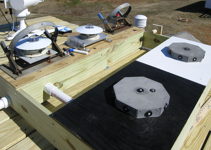1. Established A Research-grade Climate Data Collection Station for Climate-Based Daylight Modeling (Research assistant: Eric Goldman, M.Arch. Student)
 An IDMP Research Grade station (complies with CIE108-1994) has been established on the roof top platform of the existing Daylighting Research Lab located on the West Campus of NC State University to collect daylight climate data for a full-year period in Raleigh, North Carolina. The following dataset will be collected: Global horizontal illuminance, Diffuse horizontal illuminance, Illuminance on vertical surfaces facing North, East, South and West, Global horizontal irradiance, Diffuse horizontal irradiance, Air temperature, Relative humidity. more…
An IDMP Research Grade station (complies with CIE108-1994) has been established on the roof top platform of the existing Daylighting Research Lab located on the West Campus of NC State University to collect daylight climate data for a full-year period in Raleigh, North Carolina. The following dataset will be collected: Global horizontal illuminance, Diffuse horizontal illuminance, Illuminance on vertical surfaces facing North, East, South and West, Global horizontal irradiance, Diffuse horizontal irradiance, Air temperature, Relative humidity. more…
 In addition, sky luminance and radiance distributions are collected by an EKO sky scanner. The sensor head rotates in altitude and azimuth to measure the luminance at 145 circular sky patches by scanning the sky hemisphere. This capability provided by the sky scanner upgrades this station to the Research Grade per CIE108-1994. The data collected can directly feed simulation procedures for more accurate results. The establishment of this station in the southeast region of the US also serves as a continuous effort of completing the coverage of daylight climate data in this country. This project was funded by the Faculty Development Grant.
In addition, sky luminance and radiance distributions are collected by an EKO sky scanner. The sensor head rotates in altitude and azimuth to measure the luminance at 145 circular sky patches by scanning the sky hemisphere. This capability provided by the sky scanner upgrades this station to the Research Grade per CIE108-1994. The data collected can directly feed simulation procedures for more accurate results. The establishment of this station in the southeast region of the US also serves as a continuous effort of completing the coverage of daylight climate data in this country. This project was funded by the Faculty Development Grant.
2. Monitor Typical Daylighting Systems (Research assistant: Eric Goldman, M.Arch. Student)
 Eight scale models (1/2” = 1’-0”) of typical wall-based and roof-based daylighting systems have been constructed and monitored in the close proximity to the climate data collection station. Specifically, these systems include: bare window facing south and north, south-facing apertures with overhang and lightshelf, horizontal skylights, south-facing and north-facing saw-tooth skylights, and linear monitor skylights. The models are grouped in a cluster and are protected from weather by a clear acrylic dome with a visible light transmittance of 95%.
Eight scale models (1/2” = 1’-0”) of typical wall-based and roof-based daylighting systems have been constructed and monitored in the close proximity to the climate data collection station. Specifically, these systems include: bare window facing south and north, south-facing apertures with overhang and lightshelf, horizontal skylights, south-facing and north-facing saw-tooth skylights, and linear monitor skylights. The models are grouped in a cluster and are protected from weather by a clear acrylic dome with a visible light transmittance of 95%.
 Multiple photocell sensors (6 sensors for wall based systems and 8 for roof-based) are placed in each model for measuring light quantities on a year-around basis. Monitoring the sky and these daylighting models simultaneously will serve as the ultimate validation tool and provide critical information for evaluating the accuracy of any simulation methods. This project was funded by the Faculty Development Grant.
Multiple photocell sensors (6 sensors for wall based systems and 8 for roof-based) are placed in each model for measuring light quantities on a year-around basis. Monitoring the sky and these daylighting models simultaneously will serve as the ultimate validation tool and provide critical information for evaluating the accuracy of any simulation methods. This project was funded by the Faculty Development Grant.
